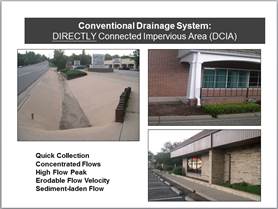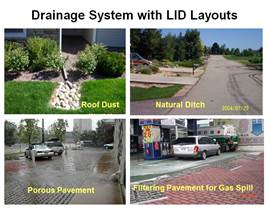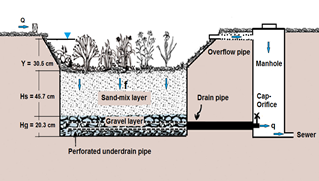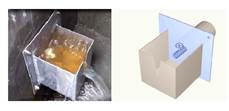�ҥH����{�b�w�g���� stormwater BMP�F�A�]��BMP�O�@�ӾDz߹L�{�A���O�ت��CStormwater BMP�O�ڭ̦b�N�����L�{�A�̫���ڭ̪��ت��C�ت��O����H�N�O���˧ⳣ�|���ܦ� Low Impact Development Environment�]LID ���ҡ^�A���O���C�}�o�]low development�^�I�ڭ̭n�C�ӳ��|�ϳ��O���}�o�F���O�B�z�Ƭx�����D�ɡA����b�X���f���a��A���q�ƥX����k�A�N���}�o�e�O�C�Ӧ��ǡC�ҥH��y�ި�A���豱�ޡA�ϳ��|�Ϥ����Ҧn�����b���}�o�@�ˡA���n��H
�ѥ��Ϫ��Ƥ��覡�O�γ������B���᪺���B���O���������H��A�A�αƺޱ��ƺު��ֳt�覡�ƥX�A�o�O�D�`���Ī��Ƥ��C�����O�����ӳo�ˤl�s�����A�ڭ����Ӿ��q�������q�A�G�ƺޱ��ƺު��Ƥ��覡���OLID�ILID�]�p���Ĥ@�B�O�b�w�y�����Y���n�@ – “minimization of directly connected impervious area (MDCIA)�C���q��֤��z���������s�����U�夣�z�����C�p�Ӥ�1�ҥܡA�����Ӥ��z���������B���n���i��������a�κڦa�CA LID layout�]�Ŷ��G���^�Ĥ@�B�O�n�D�G(1) ��MDCIA����h�A�q�w���y���|�]flow path�^�A(2) LID basins�]���ֺڻW���^and pavers�]���ֳz���h�^������m�b�W��w�y���ͳB as a runoff source control�C
  |
| �Ӥ�1 ���q��֤��z���������s����U�夣�z���� |
A LID basin �N�O���ɥ��}�o�e���p�a�A�]�N�O hydrologic depression losses�]approximately 10 to 50 mm per unit area�^�C�]���A�}��᪺LID basins �N���H�u�p�a�@�˥i�H�B�B�ҬO�AA LID basin �O���F��ֳw�y��n�q�]runoff volume reduction�^�N���۵M�p�a�l���J�g�C�۵M�p�a���I���q���H 3 to 6 months �B�q���D�C�۹��LID basin ���O���x���]Flood Detention Basin�^�A���x���O�����10-yr �� 100-yr�w�y�y�q�]runoff flow reduction�^�A�O���ϰ�ʪ��B�n�b�x���������X���f�B�C�@�Ӷ����Ϥ��A�i���\�h LID basins and pavers ��b�W�媺�����I�]source control�^�A���u�ݭn�@�� Flood Mitigation Detention Basin��m�b���U�媺�X���B�]flow release control�^�C
�o�i�Ӥ�2�N�}�l���I LID layout �[���A�ڭ̧���䪺�w���q�]street Curb�^�A�o�a�襴�}�F�A�������i�J�E��u�p�W���v�]LID basin�^�C�p�W��������AOverflow�~�y�차���C�b��Ӥ��z�����]�������ΰ����^�����[�J���������C��ت��O������������|�y�C�@�I�A��������z�����|�C1950-1970�����A�ڭ̧�w�y�����ƨ차���W�A�{�b�ڭ��������g�L�H�u�p�W���C�M�ӭn�p���LID basins and pavers �m�J�{�����Ƥ��t�ΩO�H�b���|�ϸ̭��A�̤j�x���q���O�b�����W�A�ҥH�x����F�����B�N���e���A�@LID�����ޡC�]���ALID���G���O�b�����������y���e�ҧ@�U��LID���� runoff source control�C
��1��Low-Impact Development Concept�������A�~���������䪺Buildings���ͳw�y�A�b���i�J�������e�A������R�~�a�����ä��]flush volume�^���y�JLID basin�A�x�s�b�H�u�p�W���B�A�i�溯�z�C���p�W�����F�H��A�h�l�����q�A���y�]overflow�^��H��D�A�A�q�H��D�A�y�차���W�C���������䷾�ΤU���D�O�H��5��10�~�x�����D�A�@�ʦ~�x���N�|�T�차�����ߡA����LID basin �i���f�����{���C��Building���i���x���C�p�G�@�ӳ��|�ϡA��ܰ��{����k���O��100-yr base flood elevation ����ǡA�ɫB��who cares stormwater on the street�C�C�Ӯa���f�u�n�����A�x���ɡA���e����D�|�����Ȯɩʪ��p�e�A�o�O�~���i�H�������ơC���|�ϸ̭��A�g��ޮv�B�ؿv�ޮv�A�����]�p�v�A���n���obase flood elevation ���[���C�ҥH�b��q�k�W���ɭԡA�ؿv�v�|�V�g��ޮv�M�ݤ@�ʦ~�x���쪺���{�b���̡H
�x�����y�ʬO�q�������Y�_�A�b���|�ϸ̭��A�x�������Y�O�q�γ��}�l�A�ҥH�b�x�������Y���C�I�n��LID unit�C�����bLID unit �Q�I���A�I�h�֩O�H�o�O�����įq���D�C�Ʊ�H�u�p�W���V�j�V�n�A���O�V�j�V�Q�A�ҥH��h�W�O�H����I��80%���w�y�q�A�N�O�b100�����B���B�u��20�����B�W�LLID�p�W�����x���q�C�h�l�����y�차���W�C�����O Q-design�]�Ƭx�y�q�^�A�N�O�Ⱘ�������䷾�D���e�D���覡�ӳ]�p�C�����������y��X���f���a��N���ݱƨ�U��e�t�̭��C�b�X���f���a��A�n�̷����\�X���q�]allowable flow release�^�]�pV-design�]���y��n�^�C���\�X���q�O�H��_���}�o�e���X���q�����k�C�}�o�᪺�X���q�A�`�`�O�j�L�\�X���q�A�o�ɭԫ���H�p���C�}�o�᪺�x�p�]Q-reduction�^�H���M�n�� Detention basin ���覡�ӳB�z�C�ҥH�b�]�p�@���Ƥ��D�F�u�ɡA�b�i���f�]street inlet�^���a������OLID units�F�]�N�O I-designs�C�����Ƥ��N���e�t�@�˭n�@ Q-design�A�̫�b�X���f�n�� V-design�C�o�ث��B�N�Z�����i�A�N�O���T�����ΤF�����Ƥ��Ψ��x�@�v���[�� – stormwater management for frequenct, small events and flood mitigation for extreme, large floods.
��2�@�ӮרҪ������A�Ƥ��D�F�u�q�o�@�I�}�l�A�C�� manhole ���O�@�� source of runoff because more runoff flows enter the sewer system�C�bsource���a�谵LID unit�C���O�ΫB�����]rain garden�^ or �z���h�]paver�^�ALID basin������A�h�l�������y�i�J�����C�b�����Ψ�U���D�i�J�e�t���ɭԡA�n�̷ӡu�X�y���ޡv�ӳ]�p���x���]detention basin�^�C�o�ˤl���ܡA�����]on-site runoff�^�i�H���ƨ캢�x���A�y�L�{�O�Ҩ�̤j�X���q���|���e�t�W���A��Y�e�t���~���]off-site runoff�^���|�����C�p�����x�Ƴ]�p�ϳ������������ҤΥ~��e�t���O���d���C�ҥH�AStormwater Green Concept�N�O(1)�W��LID�����Y����u�W�Ӥp���B�q�v�]reduction in runoff volume�^�A�A�[�J(2)�U�庢�x����y�ި�u�j�ӵ}���ɫB�v�]reduction in runoff flow�^�C
LID units �D�n�����: (1)�z���E���]Paver�^�P(2)�����p�W���]Basin�^�AA LID basin �W�N�O�@�Ӥp���H�u�p�a�����I�����C�p�Ӥ�3�ҥܡA�b�@���}�o���g�a�]1 to 2 hectare�^���C�I�B��LID basin�A�ڭ̬O�Ʊ���100%�I�����Y���B���C�ƹ�W�O���ӥi��A�]���������`�|���@�������w�y�O�����y�차���W�A�ӨS���g�LLID basin�A�ҥH�b�]�p�@��LID basin �ɥ��n�q�w�u�y�쭱�n�v����CA LID basin �j���O��y�쭱�n�� |/3 �� |/10�C
A LID basin is built with 30-45 �����`���a���p�W�����B�a�U�A�@�h��]sand-mix�^�B�@�h���Y�]gravel�^�B�A�[�J�z�����Ƥ�����(perforated sub-drain pipe)�CLID basin�J�i�H�a���I�W���A�S�n�a�U�z���B�Ϊ��ާl���αƤ��CA LID basin �O�@�������C�����_�q�j���n���y�첣�͡B�A�y��o�@�Ӥp�p�������W�C�����s��b�a���p�W�����A���������_�]�����ު��j�O�l���ӤU���C�p���A�����N�i�H�û����a���Ѥ��Φa�U�Ƥ����`�����C�ꤺ�H�����n���E�z���h�E���C�շQ�Y��Ӷ������n���O�����E�����ܡA�o������@����z�H��]soil saturation�^�A�a�U���w�v���C�oLID�����N���A�l���]�]���S�����ޱƤ��^�CA LID unit ���ר�j�Τp�A��ĪG�O�b��O�_���y�Z�q�A�Y�u�O�@�y�����A�hLID�����j�ӵL�ĨäϼW���K�C
LID�z���E���]Paver�^�W�u�����������y�ʦa�����A���y�ʫܧ֡A�ҥH�����n�bPaver���U����@�h�j���Y�]gravel�^�C���Y�h���ջشN�ܦ��a���U�W���\��C������Y�h�����H��A���~��V�U�z�����l�h�CLID Paver�������Q�F�h�b�U�B�A�[�ۼh�b�W�CLID Basin ���Q�ۼh�b�U�B�A�[�F�h�b�W�C�p���A�~�O���Ī��W�B���B�l�B�ƪ����\��t�ΡC�p�G���Y�h���h��ϤF�ALID unit�u�����\�CThe operation of a LID unit is always flow-path dependent�A�ҥH�������w�n���ԷV�C�I�u�O�@�h���@�h�[�\�A���藍�O�����i�H�ξ���ӳB�z���A�p�Ӥ�4���רҩҥܡC
A LID unit ���Ƥ��ɶ��]drain time�^�n�h�[�H���p�ɡH�Q�G�p�ɶܡH�|�Q�K�p�ɶܡH�n����@�ӡH�x�W�b���B�u���ɭԡA�C�ѤU�B�C�b���u���ܡA�n�X�ѨS���B�C�ҥH�Y��Q�G�p�ɥH�T�O����R���L�o�C�b�B�u�ɡA�~���|��������LID�Ѥѳ��@�y���H�䦸�ALID�������ʱƤ��]�|�o���v���D�A�p��̻ݭn�q�w�Ƥ��ɶ��O�]�p�����D�C�䦸�n��LID basin ���a���p�W���`�O�h�֡H����Denver����30 �� 45�����C�x�W���B�u���@�ˡH�x�WLID basin ���Ӧh�`�H�o�M�I���q�����C����EPA��ijLID unit ���]�p�I���q�OWater Quality Capture Volume�]QWCV�^�AWQCV���ӯ���j��i�H�I�U80%�����B�w�y�q�C�άO�C100�����B���A�u��20���B�q�|�T���ú��LLID unit ���I���p���C�]�N�O�����@�ʳ����B�A�Y�q�p�ƨ�j�A�h�ĤK�Q�������B�q�N�OWQCV�C�x�W�{�b�Ҽ{�H40��50mm���O�|���q�ӳ]�pLID unit�C���M���ꪺWQCV�j���O10��20����A���ѹ�4�������A��ı�o�x�W��45mm�O�|���q�O�i�����A�]���x�W��LID�ݦ����x�\��C
�U��5���O�@��40�̭�50�̪��@�ӫؿv��a�A�ڭ̧�䤤��10�̼e���Ӱ�LID basin�A�|��@�����n��ҡC�O�|���q�O45mm�A�ҥH45mm����d����̡A�ݭn�E�Q�ߤ�̪��p�W���q�CLID unit���������n�O�Q�̪��e�סA�|�Q�̪����סA�������O�|�ʥ���̡C�p�G�n�㦳�E�Q�ߤ�̪���n�A���W���`�O0.225�̡C�p�G�W�h���A�⪺�ջؤ�]porosity�^�O25%�C�U�h�Z�۬O���ջؤ�O40%�C�ڭ̨�0.42�̪���h��0.30�̪��Z�ۼh�A��o��Ӫ��`���W�����ջؤ�A��n�O0.225m�����`�C�o�N�OLID unit's underground storage�C�U�@�ӬD�ԬO�Ʊ� LID unit's drain time �O�Q�G�p�ɡA�]�N�O�b�Q�G�p�ɤ��A��0.225m���a�������J��ΧZ�ۼh���C0.225m/l2hr �O�����q�O18.75mm/hr�C�հݭn����̥h��㦳�p�������ʪ��g��V�X��]sand-mix�^�Υ۬�V�X��]gravel-mix�^�H
�o�˪��@�ӫا��n���شM�H�N�⦳�ا��S�p��T�w�亯���\��C�o�ɭԧڭ̴N�ݭn������]�p�Ӥ�5�^�A�}�l��Τg�t�ơA�b����Ṋ̀��@���@�������A�ڭ̥�85%����l�[15%��֡C��B������A��־�F��Ѫ��ɭԡA�諸��s�@�ˡC�ڭ̤]�ά�M�䥦�o���ΩU���t�ơA�Ҧp��n���G�k�A���ȡA�½��L�Arecycled ����j�Y�C�ڭ̵o�{���ǰt�Ƨt�P�q�Ӱ��Χt�Ķq�Ӱ��C�@��i�h�H��A��a�h�O���ìV�C
���F����Ǥ��~�A�Ӥ�6�O�ڭ̪����~���� field test on rain garden�C�o��LID rain garden ��400����^�`�A��y�쭱�n�O��^�a�]acres�^�A����y���B���C�i���f�O�α��䷾�����ݡC�ڭ̥Τ@�� rectangular weir �Ӵ��J���q�C�o�O3���ز`���a�U�[�����A�������y�J�@���K�����A�g�L�@��triangular weir�Ӵ��X���q�C�p�[�����רҩҥܡA�u���e�����w�y�O�Q rain garden �I���C�h�b������w�y�O���y�q�L rain garden�C��o�����B rain garden ���o���ǷL����֬x�p���ĪG�]dQ�^�C���s����ɶ������B�Arain garden �B���C���y�O�T�w���Y�B���X���h�Bí�w�����C�B����A���y�~�v����֡C�b����u�A���������i��A����͡C�]���Ƥ��֤S�����O�\�Ĥ~�O�x�W LID unit ���S��C
CONCLUSION
A LID unit �D�n�O���� hydrologic depression loss for frequency runoff events. A detention basin �D�n�O���� hydrologic infiltration losses and the impact of flow concentration during extreme events. A LID unit has a diminishing effect on the peak flow reduction. In general, a LID may have a significant impact on 2- to 5-yr peak flow reductions, while it has almost no impact on 10- to 100-yr peak flows. If we like to expand a LID to function for both reductions in runoff volume and peak flow, then the LID unit can be connected to a downstream detention basin. For a small catchment, this detention basin can be an underground vault, while an on-surface basin may serve a large catchment for flood mitigation purposes.�]�p��6�^
The more LID units we built, the more maintenance we will impose on ourselves. A LID unit has its life cycle of 10 to 15 years. Management details for LID units need to be legalized and enforced through the local regulatory agencies or home owner associations. A regular maintenance program must be established for who will be in charge and who shall share the cost for every major LID unit. ���i�즹�����A���¦U��C
�ݡG���Ѯv�A�n�A�@��²�u�����D�бСA���e�ڭ�ť�LLID�t���CLID�j���O�@�~�W�v�����B�C�A�t���@�}�l�]����LID��w2-5�~�W�v�����B�C�]���x�W����ꪺ���p������@�ˡA�A��]����O�_�����~�������B�j���O78.8 mm ���k�ALID��2-5�~���B�q�O���ˡC
�ϡG�p�G�ڭ�~����LID�O�H2-5�~�W�v�����B���]�p�B�q�A���@�w�O���F���~�C�ڭ̤��Ρu�~�ŧǡv���W�v���Y�Ӵy�zLID���]�p�B�q�C�ڭ�~�j�լO����d�I80%�����B�w�y�q�C�Ҧp�ڦ��@�ʦ������B�A�q�p�ƨ�j�Fa LID unit ����100%�d�I�e�K�Q�����B�Ҳ��ͪ��w�y�q�C�o�OLID�]�p��¦�C�Y�A�n��78mm�A�ڻ{���y�L�L�Y�C�ڻ{��45mm���M���@�I�A���i�H�����]�i��CLID�O���ɶ}�o�e�� depression losses.
�ݡG���Ѯv�O���O���ڭ̤@�ӰѦҼƦr�A�j��LID���B�j�O�h�֡H
�ϡG�ڭ̳q�`�� rainfall event depth (Note: runoff volume = runoff coefficent x rainfall depth x area) ��LID �p�q�C���p�U�@�ʳ��B�A��o�@�ʳ������B�q�������O�� average rainfall event depth�C�o���O�DzΤ��夤�� rainfall depth-duration ���ݦ~�ŧǤ��R(annual maximam series)�C�u�Ҽ{�C�~�@���̤j�x����Log-Person III�i����100�~�@�J�x���q�C�C�@�ʦ~���̤j�x�����u�~�ŧ�non-exceeding probability�v�O99/100�C���F�]�pLID units�A�ڭ̶��n���R���~�өҦ������B�Ψ�u���ŧǡv���έp���G�C�Ҧp��~�����@�ʳ����B�F�̤j�@�����u���ŧ�nonexceeding probability�v�]�O99/100�C����̫o�j�j���P�C���קK�V�c���M�A�bLID���]�p���F��]�p���B�O�H�u���ŧ�nonexceeding probability�v�ӭq�w�F�]�N�O�Q�٬��u�I���v�v(runoff capture rate)�C���I���v�O80%�����ŧǪ����B�q (WQCV)�A�X�G�O3��6�Ӥ�@�J���~�ŧǪ����B�q�C�@�~�̭�LID unit �����|���⦸�T���C���o�i�����I��80%�����B�w�y�C
�ݡG�ڷQ�б�LID�]�I�̺�������infiltation rate�O�ܭ��n�A���S���i��clogging�|���C�����BMP�����ìV���\��C
�ϡG�D�`�n�����D�C�ڥ��ӷQ���A���S���ɶ��h�ӽͳo�Ӱ��D�C��\LID������ɭԡAinfiltartion rate�D�`���C�i�H���� 10 �� 15 inch/hour�A�X�G�O45mm/hour�C�M�ڭ̦b����ǰ��X�Ӫ��ۦ��C�����z�֡A����ި�S���F��зǡC�ҥH�ڭ̫���H�ڭ̴N�b������q, �b���ޥX���f���ˤ@�Ӥ��s�Y�C��infiltation rate �Ӱ��ɡA�ڭ̧���s�Y����@�b�A�����X���q���C�C�X���q���C���N��N�O�������U�ӡB���X���h! �ҥH���sand-mix layer becomes saturated�C���y�ʺC�A�N�i�H�F�� water quality improvement�C���� LID unit �~���j�F�Aclogging effect �Ϥ����ʶV�ӶV�C�A�o�ɭԧڭ̦A����s�Y���}�C�ҥH�ڭ̥i�H���ⶥ�q�B�T���q�����ΡC�ڭ̳o�˰��A�J�i�H�O������A�S�i�H�������ާ@�O����ŦX�g�ٮįq�C
(Many valve operations can be well controlled through the web-based remote control or there is no need of hand operations in field.)

|
 This is the outlet of seepage flow from a rain garden. The seepage flow is adjusted by a cap orifice and measured with a weir. Nowadays, a field valve can be operated with a web-based remote control from a distance. This is the outlet of seepage flow from a rain garden. The seepage flow is adjusted by a cap orifice and measured with a weir. Nowadays, a field valve can be operated with a web-based remote control from a distance.
|
|
| |
�ݡG�b������A�o�{�A�ܳ��w�� urban waste materials�A���O����life cycle�ܮe�����C�A������|���o�ؿ�ܡA��L�� materials���O�@�˥i�H�F��ĪG�ܡH
�ϡG��]�O�o�ˤl�A�ڭ̷��ɪ� LID Research Team�A���@�b�O Landscaping Experts�A�L�̴��ѧڭ̩Ҧ����P�� urban waste materials�C���H�����~�B�Q�G�B�Q���B�ª��j�Y�B�u���ȡB�½��L�C�ڭ̸g�L chemical processes�A�g�L�z�蠟��A�ڭ̻{��soil and���βV�X���̮e���զX�A�S�K�y�C����F���{�b�n�D�g�a�}�o�@�w�n�@ stormwater LID�A�]���}�o�����ܰ��A�л��N���C�����N��軡�u�����_�v�ALID ���]�p�ܦ��@�� social-economic problem�C�ҥH�ڭ̥ثe����ܤ]�\���O�̦n���A���O�ھڧڭ�Denver���a���g�ٮĪG�C
REFERNCES:
Guo, James C.Y. and Mackenzie, K (2014). “Modeling Consistency for small to large watershed studies”, ASCE J. of Hydrologic Engineering, V 19, N8, Aug , 04014009-1 to -7.
Guo, James C. Y. Urbonas, B. and MacKenzie K. (2014) “Water Quality Capture Volume for LID and BMP Designs”, ASCE J of Hydrologic Engineering, Vol 19, No 4, April, 682-686
Guo, James C.Y. and Urbonas B. (2014) “ Volume-based Runoff Coefficient”, ASCE Journal of Irrigation and Drainage Engineering, V 140, N 2, Feb, 04013013-1 to -5.
Guo, James C.Y. (2014). Discussion on “Storm Centering Approach for Flood Predictions from Large Watersheds”, ASCE Journal of Hydrologic Engineering, Vol 19, No 1,Jan., pp 272-274
Guo, James C.Y. (2013). “Green Concept in Stormwater Management”, Journal of Irrigation and Drainage Systems Engineering, Vol 2, Issue 3, ISBM 2168-9768.
Blackler, G. and Guo, James C.Y.(2013). “Paved Area Reduction Factors under Temporally Varied Rainfall and Infiltration”, ASCE Journal of Irrigation and Drainage Engineering, Vol. 139, No. 2, February 1,
Blackler, G. and Guo, James C.Y., (2012). “Field Test of Paved Area Reduction Factors using a Storm Water Management Model and Water Quality Test Site," ASCE Journal of Irrigation and Drainage Engineering, Vol. 17, No. 8, August.
Guo, James C.Y. (2012). “Storm Centering Approach for Flood Predictions from Large Watersheds”, ASCE Journal of Hydrologic Engineering, Vol. 17, No. 9, September 1,
Kocman, S. M., Guo, J. C.Y. and Ramaswami A. (2012).” Waste-Incorporated Sub-base for Porous Landscape Detention Basin“, ASCE Journal of Environmental Engineering, Vol 137, No 10, Oct,
Guo, James C. Y. Cheng, Jeff, Wright, L.(2012) “Field Test on Conversion of Natural Watershed into Kinematic Wave Rectangular Planes, ASCE J. of Hydrologic Engineering, Vol. 17, No. 8, August.
Guo, James C.Y. (2012). “Off-stream Detention Design for Stormwater Management”, ASCE Journal of Irrigation and Drainage Engineering, Vol. 138, No. 4, April 1.
Guo, James C. Y. Shih, H. M. and MacKenzie K. (2012) “Stormwater Quality Control LID Basin with Micro pool”, ASCE Journal of Irrigation and Drainage Engineering, Vol. 138, No. 5, May 1.
Guo, James C.Y. (2012). “Cap-orifice as a Flow Regulator for Rain Garden Design ASCE J of Irrigation and Drainage Engineering, Vol. 138, No. 2, February.
Guo, James, C.Y., Urbonas, B., and K. MacKenzie (2011). “The Case for a Water Quality Capture Volume for Stormwater BMP”, J. of Stormwater, Oct.
Guo, James C.Y., Blackler, E G, Earles, A, and MacKenzie, K (2010) "Effective Imperviousness as Incentive Index for Stormwater LID Designs” ASCE J. of Irrigation and Drainage Engineering, Vol 136, No12, Dec.
Guo, James C.Y., Jones, J. and Earles, A.(2010). “Method of Superimposition for Suction Force on Trash Rack”, ASCE J. of Irrigation and Drainage Engineering, Vol 136, No11, Nov.
Guo, James C.Y., and Jones, J. (2010). “Pinning Force during Closure Process at Blocked Pipe Entrance”, ASCE J. of Irrigation and Drainage Engineering, Vol 136, No2, Feb.
Earles, T., Guo, J., MacKenzie, K., Clary, J., and Tillack, S. (2010) “A Non-Dimensional Modeling Approach for Evaluation of Low Impact Development from Water Quality to Flood Control”. doi: 10.1061/41099(367)32
Low Impact Development 2010: pp. 362-371.
Guo, James C.Y. (2010)“Preservation of Watershed Regime for Low Impact Development using (LID) Detention”, ASCE J. of Engineering Hydrology, Vol 15, No 1., January.
Guo, James C.Y., Kocman, S and Ramaswami, A (2009) “Design of Two-layered Porous Landscaping LID Basin,”, ASCE J. of Environ Engineering, Vol 145, Vol 12, December.
Guo, James C.Y. and McKenzie, K, and Mommandi, A. (2008) “Sump Inlet Hydraulics”, ASCE J. of Hydraulic Engineering, Vol 135, No 1, Nov.
Guo, James C.Y.(2009) “Retrofitting Detention Basin for LID Design with a Water Quality Control Pool”, ASCE J. of Irrigation and Drainage Engineering, Vol 135, No 6, October.
Guo, James C.Y. and Urbonas, B. (2009) “Conversion of Natural Watershed to Kinematic Wave Cascading Plane”, ASCE J. of Hydrologic Engineering, Vol 14, No. 8, August.
Guo, James C.Y., (2009) “Grade Control for Urban Channel Design”, Elsevier Science, J. of Hydro-Environmental Research, Online publication complete: 18-FEB-2009 DOI information: 10.1016/j.jher.2009.01.001, February/March, pp 1-4.
Guo, James C.Y. and Harrigan, Kelly (2009). “Conservative Design Rainfall Distribution”, ASCE J. of Hydrologic Engrg. Volume 14, Issue 5, pp. 528-530
Guo, James C.Y. and Gerald Blackler. (2009) “Least Cost and Most Efficient Channel Cross Sections”, ASCE J. of Irrigation and Drainage Engineering, Vol 135, No. 2, pp 248-251 (March/April 2009)
Guo, James C.Y. and Cheng, J. Y.C.(2008) “Retrofit Stormwater Retention Volume for Low Impact Development (LID)”, ASCE J. of Irrigation and Drainage Engineering, Vol 134, No 6, December.
Guo, James C.Y. and Urbonas, B (2008) “Consistency between Colorado Urban Hydrograph Procedure and Rational Methods,”, Annual Natural Hazards News, published by Urban Drainage and Flood Control District, Denver, Colorado
Guo, James C.Y. (2008) Runoff Volume-Based Imperviousness Developed for Storm Water BMP and LID Designs”, ASCE J. of Irrigation and Drainage Engineering, Vol 134, No 2, April.
Guo, James C. Y. (2008) Inflection on Recession Hydrograph, Response to Reader’s Discussion on Dimensionless Kinematic Wave Unit Hydrograph for Storm Water Predictions, Vol 132, No. 4, ASCE J. of Irrigation and Drainage Engineering, July/August, Vol 134, No 2, ASCE J. of Irrigation and Drainage Engineering, April.
Guo, James C.Y. (2007) “ DOC. 1052 No. 869 for Videotape and Audio Deposition of James Chwen-Yuan Guo Recorded for Case of Andrew Sieger, Estate of Chad Sieger (Deceased) Versus The City of Omaha, Nebraska” in the District Court of Douglas County, Nebraska District Court, Omaha, Nebraska, June 4, 2007
Guo, James C.Y. (2007) Stormwater Detention and Retention LID systems, Invited, J. of Urban Water Management, July
Guo, James C.Y., Urbonas, B., Mackenzie, K, and Lloyd, D (2007) Stormwater Computer Design Tools, Invited, J. of Urban Water Management, July
Guo, James C.Y. and Clark, J. (2006). “Rational Volumetric Method for Off-line Storm Water Detention Design”, J. of PB Network for Water Engineering and Management, Vol 21, No 3, Issue No. 64, December.
Guo, James C.Y. and Hsu, E.S.C. (2006). “Hydrologic Modeling Consistency and Sensitivity to Watershed Size”, J. of PB Network for Water Engineering and Management, Vol 21, No 3, Issue No. 64, December.
Guo, James C.Y. (2006). “Decay-based Clogging Factor for Curb Inlet Design”, Vol 132, No. 11, ASCE J. of Hydraulic Engineering, November.
Guo, James C.Y. (2006). “Stormwater Predictions using Dimensionless Unit Hydrograph”, Vol 132, No. 4, ASCE J. of Irrigation and Drainage Engineering, July/August.
Guo, James, C.Y., Hsu Eric S.C., and Chen, Jeffery (2006). “����x�����y���a���Φa�U�t�� Sustainable Surface-Subsurface Storm water Retention System” Vol 14, No. 2, Journal of China Institute of Water Resources and Hydropower Research, June.
Jones, J, Guo, J.C.Y., and Urbonas, B. (2006). “Safety on Detention and Retention Pond Designs”, J. of Storm Water, Jan/Feb.
Guo, James C.Y. (2006). “Overland Flow Model for Hot Asphalt Oil Spill”, Vol 78, J. of Environmental Management, pp 102-105.
Guo, James C.Y. (2004). “Design of Urban Channel Drop Structure”, J. of Flood Hazards News, December,
Guo, James C.Y. (2004). “Hydrology-Based Approach to Storm Water Detention Design Using New Routing Schemes,” ASCE J. of Hydrologic Engineering, Vol 9, No. 4, July/August
Guo, James C.Y. (2003). “Design of Infiltrating Basin by Soil Storage and Conveyance Capacities,” IWRA International J. of Water, Vol 28, No. 4, December.
Guo, James C.Y. (2003). Response to readers’ discussion on "Rational Hydrograph Method for Small Urban Catchments," ASCE J. of Hydrologic Engineering, Vol 2, No.1, May/June.
Waugh, P.D., Jones, J.E., Urbonas, B.R., MacKenzie, K.A., and Guo, J. C.Y. (2002) “Denver Urban Storm Drainage Criteria Manual.”, ASCE J. of Urban Drainage, Vol 112, No 56.
Guo, James C.Y. (2002). “Overflow Risk of Storm Water BMP Basin Design,” ASCE J. of Hydrologic Engineering, Vol 7, No. 6, Nov.
Guo, James C.Y. and Urbonas, Ben. (2002). “Runoff Capture and Delivery Curves for Storm Water Quality Control Designs,” ASCE J. of Water Resources Planning and Management, Vol 128, Vo. 3, May/June.
Guo, James C.Y. and Hughes, William. (2001). “Runoff Storage Volume for Infiltration Basin,” ASCE J. of Irrigation and Drainage Engineering, Vol 127, No. 3, May/June.
Guo, James C.Y. (2001). "Rational Hydrograph Method for Small Urban Catchments," ASCE J. of Hydrologic Engineering, Vol 6, No.4, July/August.
Guo, James C.Y., Urbonas, Ben. and Stewart, Kevin. (2001). “Rain Catch under Wind and Vegetal Effects,” ASCE J. of Hydrologic Engineering, Vol 6, No.1, in Jan.
Guo, James C.Y. (2001). “Design of Circular Infiltration Basin Under Water Mounding Effects,” ASCE J. of Water Resources Planning and Management, Vol 127, No.1, Jan/Feb.
Guo, James C.Y. (2000). “Street Storm Water Conveyance Capacity,” ASCE J. of Irrigation and Drainage Engineering, Vol 126, No 2, Mar/Apr,
Guo, James C.Y. (2000). “Street Storm Water Storage Capacity”, J. of Water Environment Research, Vol 27, No 6., Sept./Oct.
Guo, James C.Y. (2000). “A Semi-Virtual Watershed Model by Neural Networks,” J. of Computer-Aided Engineering, Special Issue for Evolutionary and Neural Network Computing”, Vol 15, BLACKWELL publishers, Nov.
Guo, James C.Y. (2000). “Design of Grate Inlets with a Clogging Factor,” Advances in Environmental Research, Vol 4, Elsvier Science, Ireland.
Guo, James C.Y. (2000). “Storm Hydrographs for Small Catchments,” IWRA International J. of Water, Vol 25, No. 3, September. |